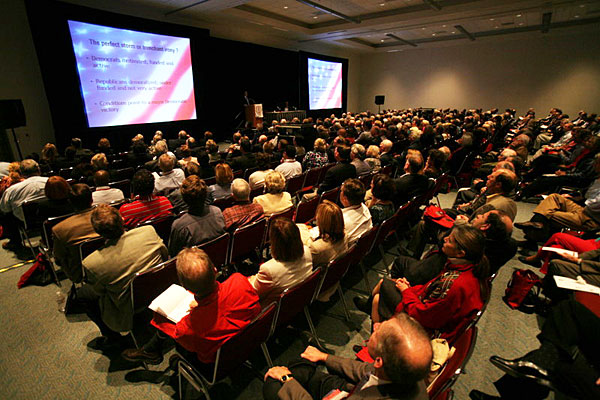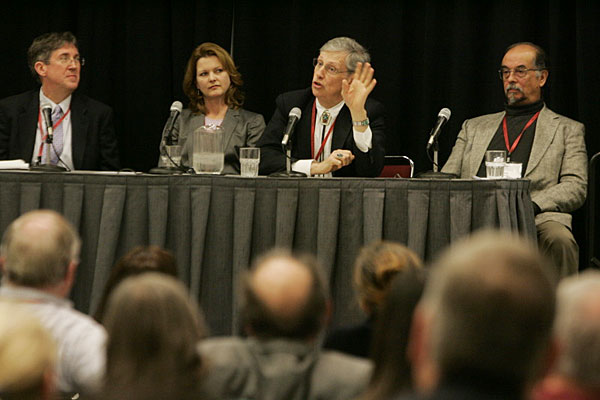Leading Matters visits San Diego, drawing big alumni crowds

Alumni Ken King, BS ’60, MBA ’63, and Sheryl Smith King, BA ’63, attended the San Diego gathering.

A standing-room-only crowd listens as faculty members discuss the 2008 presidential election.

Faculty panelists discuss “Troubled Waters: Western and Global Perspectives” at Leading Matters in San Diego. From left: Barton H. “Buzz” Thompson, co-director, Woods Institute for the Environment; Jenna Davis, an assistant professor of civil and environmental engineering; David Freyberg, an associate professor of civil and environmental engineering; and Jim Leckie, a professor of civil and environmental engineering.
Alumni longing for a taste of their university days were treated to a feast of Stanford sights and sounds recently in San Diego at "Leading Matters," an event designed to showcase how their alma mater is tackling some of the world's biggest challenges.
There were new videos, shot with state-of-the-art digital video cameras, starring students and faculty working on research projects at home and abroad.
The campus—its labs and landscape—played supporting roles in the videos, and the audience broke into spontaneous applause as the camera dropped through cloud cover, swept across the Oval and rose over the Main Quadrangle.
More than a dozen faculty members, including the deans of the schools of Education, Humanities and Sciences, and Medicine, offered perspectives on key issues of the day during panels and seminars, then took questions from audiences eager to find out more.
It was a day for reuniting with former classmates and connecting with friends made in the intervening years at other Stanford events. It was a day for wearing Cardinal red.
"Nice blazer," a man called out to a woman wearing a bright red linen blazer. "I've got my tie," he said, flapping his red tie for emphasis. "I've had it for 30 years."
More than 600 people—alumni, guests, faculty members and students—attended the March 8 Stanford alumni gathering at the San Diego Convention Center.
So did four of the six Burghers of Calais—or, to be more precise, their body doubles did, serving as stand-ins for the venerable bronze statues back at Memorial Court. The burghers stood in the four corners of a ballroom where dinner was served.
It was the second stop in a 17-city tour sponsored by The Stanford Challenge and the Stanford Alumni Association.
The mission of The Stanford Challenge is to build a university for the 21st century and beyond—a university that will better serve the world through the quality, impact and vision of its research, and through a new generation of leaders it will educate. The campus-wide effort involves several multidisciplinary initiatives focusing on the arts and creativity, the environment and sustainability, human health, international affairs and K-12 education.
"This is a university willing to take chances, to push the boundaries, to work in collaborative new ways to try to make a difference in our world," President John Hennessy said in his welcoming address. "The Stanford Challenge is our initiative to do this. It's an ambitious plan for the university. We're making great progress, and I think as you'll see later today, from our faculty leaders, wonderful things are happening."
In San Diego, the alumni crowd spanned many decades and a diverse set of interests. More than a dozen men and women who graduated 60 or more years ago came to the event.
Sitting at a small table in a wide sunny hallway outside the meeting rooms, Sheryl Smith King, who earned a bachelor's degree in English literature from Stanford in 1963, put on her blue-rimmed glasses and scanned the day's program, which listed six faculty seminars and panels.
Since three of the faculty presentations started at 2:30 p.m. and another three began at 5:30 p.m., choices had to be made.
"I think I'll go to 'Troubled Waters—Western and Global Perspectives' during the first session and 'Presidential Election 2008' during the second," said King, who attended "Leading Matters" with her husband, Ken King, MBA '63. "If you're interested in knowledge and learning about new things, what better way to do that than to come to one of these events," she added. "They bring amazing people down from Stanford."
Don Kidder, who earned a bachelor's degree in political science from Stanford in 1971, chose a pair of presentations that reflected his interest in social-justice issues: "Clash of Cultures" and "Reforming California Schools: Lessons from Research and Practice."
A dozen students, standing beside posters describing research and service projects, greeted the earliest arrivals. They returned to their posters in between sessions—and when drinks and dessert were being served—to talk to alumni who crowded around their easels.
One of the students was Tress Goodwin, who earned a bachelor's degree in human biology and a master's degree in Latin American studies at Stanford, and is now a student at Stanford's School of Medicine. Her poster was titled "In Case of Emergency Dial 108: Building Pre-Hospital Capacity in India."
Christian Torres, a junior majoring in human biology, presented "Mind Matters: How the Study of Neuroscience and Behavior Can Be Everywhere in the Life of a Stanford Student."
They both appeared onstage—along with an undergraduate majoring in management science and engineering, and a graduate student in computer-based music theory and acoustics—for a conversation with President Hennessy.
When Hennessy asked Goodwin why she had decided to become a doctor, she attributed the decision to a life-changing experience in Peru, where she spent a summer studying teenage pregnancy and education with the help of a Stanford grant. It was there she realized how much more she could accomplish, especially in a foreign country, if she earned a medical degree.
"Having those two little letters after my name will certainly enable me to do a lot more than if I had not done that," Goodwin said, and, in an aside that surprised the audience, added: "Medical school itself was a pretty fun time."
"Not too intense?" Hennessy asked.
"Surgery was a couple of bad months there, but the rest was a blast," she said.
"Worse for the patients," Hennessy joked.
Joining in the laughter that rippled through the audience were Mark Neary, who earned an MBA at Stanford in 1984, and his nephew, Eric Dunn, a high school student in Anaheim Hills who had arrived in San Diego that morning by train for the event.
"It's interesting to see what Stanford has to offer—not only what they're trying to do for the future, but the people who are trying to do those things," said the 17-year-old Dunn. "They want to be on the forefront of what's going on."
Over the next three years, Stanford will present "Leading Matters" events in cities across the United States, including San Francisco, Houston, Washington, D.C., and New York.
The tour began in Seattle in January 2008 and will end in Portland, Ore., in May 2011. In between, the tour will travel to Hong Kong, London, Mexico City, Shanghai and Tokyo.

Share This Story